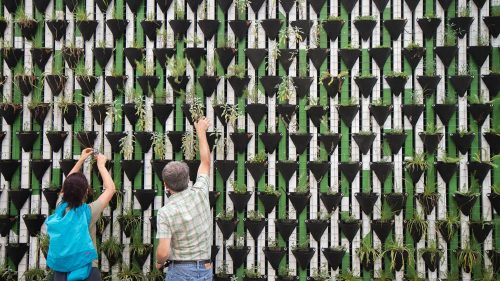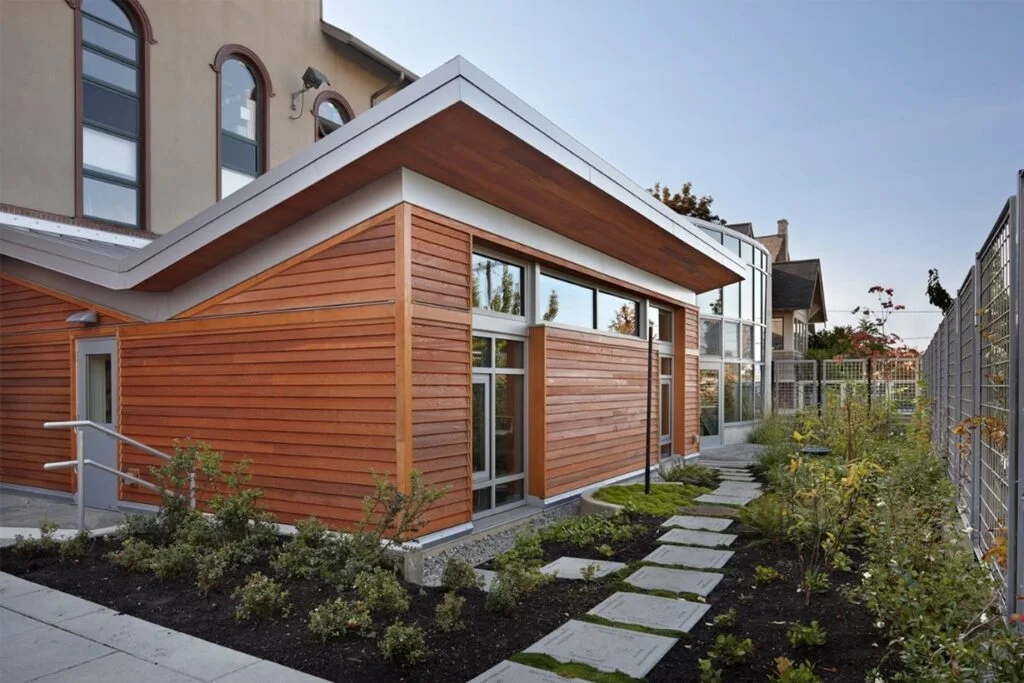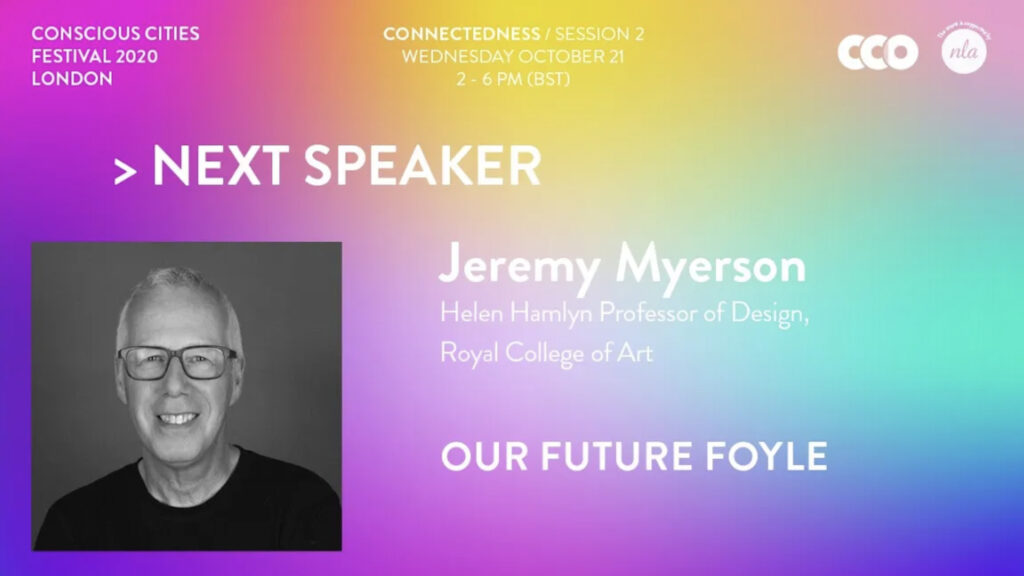1. Health, wellness, and experience as core elements of green buildings
The concept of Conscious Cities has been defined as a new field that proposes to replace the focus on efficiency in the built environment with a focus on human health and well-being. It is a concept that “arose in reaction to the widening gap between our potential to design with the human experience in mind, and its lack of application in practice.”1 Although by no means substituting efficiency, there has recently emerged within the green building industry a complementary focus on human health, wellness, and experience.
This refocusing of priorities stems from the recognition of a failure of humanism in the way we design, building and operate the built environment. Modern humans have essentially become an indoor species, with people in the industrialized world spending almost 90 percent of their time inside buildings2. Many of modern society’s chronic health issues related to lack of physical activity, stress, and poor diet, can be directly or indirectly linked to the architecture of buildings and cities
And yet, the humanistic element has been systematically overlooked by many in the industry. This is not to say that those in the industry have completely ignored it. Building codes, for example, have dictated performance requirements related to indoor air quality, ventilation rates, and thermal comfort. And while health and wellness considerations have also been integral to various green building rating systems, it has often taken a backseat compared to other environmental criteria such as energy performance, water management and material selection.
Consideration of the human dimension in green buildings has gained momentum in recent years. The World Green Building Council noted in 2015 that “a new market demand is emerging within the building industry: to more intentionally address human experience, health, and wellness as core elements of green building practice”3. Similarly, the American Institute of Architects predicted that “by facilitating greater collaboration with the public health community, there is an opportunity for green buildings to move past the premise of “do no harm” to a focus on holistic health promotion.”4
This development partly arises from economic considerations. On average, 90 percent of typical business operating costs are employee related (salaries and benefits), while nine percent goes to rent, and only one percent to energy. Therefore, even a modest reduction in sickness or absenteeism can lead to a meaningful reduction in overall operating costs
1.1. Green building rating systems, standards, and guidelines
In conjunction with (or perhaps due to) this renewed focus on the relationship between health and the built environment, various rating systems, standards, and guidelines have emerged.
1.1.1. LEED
The LEED green building rating system developed by the U.S. Green Building Council (USGBC), is the most popular and widely-adopted third-party green building rating system in North America. It contains different requirements for the design and construction of new buildings, interiors and communities, as well as for the operation and maintenance of existing buildings. While LEED has always included many strategies related to human health and wellness — for example thermal comfort, indoor air quality, and daylighting — it has been only a minor component of the overall scoring system.
Luckily, revisions to the rating system – most recently the update to the LEED Version 4 – continuously raise the bar for metrics and criteria related to health. One such example are the requirements for daylighting. Whereas previously the daylighting requirements simply dictated a minimum illuminance level in order to demonstrate compliance, the updated LEED v4 requirements dictate that projects must meet a tighter, more specific range of illuminance levels, use more sophisticated and nuanced daylighting modeling techniques such as spatial daylight autonomy, and be modelled or measured at different times of the year and under different sky conditions. LEED v4 also has more nuanced requirements for improving daylight quality by minimizing glare.
Furthermore, additional “pilot” credits have also been introduced to LEED. Pilot credits provide projects with the opportunity to test more innovative strategies that aren’t included in the base rating system. Some of the LEED pilot credits available related to health and well-being include: Integrative Process for Health Promotion, Enhanced acoustical comfort and performance, Learning controls for thermal comfort, and Design for active occupants, among others.
1.1.2. Arc
The USGBC and the Green Business Certification Institute (GBCI) recently launched Arc, a software platform that allows individual buildings, communities, and even entire cities, to measure and benchmark sustainability performance on an ongoing basis. Arc users are given a performance score based on five categories: Energy, Water, Waste, Transportation, and Human Experience. For buildings, the Human Experience performance score is based on indoor air quality and post-occupancy surveys used to gauge occupant satisfaction on an ongoing basis. The Arc platform is integrated with building sub-systems, using the LEED Dynamic Plaque to provide building occupants with a visualization of the building’s score.
For larger communities and cities, the Human Experience category is based on data and indicators related to education, prosperity, equitability, and health & safety, using such metrics as median air quality, green space per capita, and average noise levels.
1.1.3. Living Building Challenge
Developed by the International Living Future Institute (ILFI), the Living Building Challenge is the most advanced measure of sustainability in the built environment that exists today. Criteria required to achieve certification include those related not only to stringent quantitative building performance metrics, such as net-zero energy and net-zero water, but also more qualitative human-centric criteria related to beauty, equity, health and happiness. Projects must incorporate strategies that emphasize civilized and humane spatial environments that are intended solely for human delight. While similar to LEED and other green building rating systems that require projects to demonstrate specific sustainability performance, it is unlike them in that in order for a building to be certified as “Living”, buildings are required to demonstrate achievement of each requirement — there are no optional strategies or criteria.
The overall mission of ILFI is to create buildings and communities that are “socially just, culturally rich, and ecologically restorative.” Certified living buildings, therefore, are healthy, beautiful, and regenerative spaces that connect people to light, air, food, nature, and community and create a positive impact on human and natural systems. The Living Building Challenge is as much a philosophy as it is a design tool and certification system.
1.1.4. WELL
The WELL Building Standard, launched in 2014, is the first rating system that focuses exclusively on human health and wellness in the built environment. WELL is structured similarly to LEED in that it allows new and existing buildings, interiors, and communities to implement specific mandatory requirements as well as additional optional strategies towards certification. It is based on various mandatory requirements (Preconditions) and optional strategies (Optimizations) divided into seven concept areas (some examples of the Preconditions and Optimizations are provided in parentheses):
- Air (e.g. ventilation, air filtration, humidity control, advanced air purification, toxic material reduction)
- Water (e.g. advanced water quality standards, drinking water promotion)
- Nourishment (e.g. access to healthy foods, reduction in food advertising, food production and preparation)
- Light (e.g. circadian lighting design, glare control, colour quality, daylighting)
- Fitness (e.g. interior fitness circulation, exterior active design, fitness equipment, active furnishings)
- Comfort (e.g. accessibility, ergonomics, acoustic comfort, thermal comfort, olfactory comfort)
- Mind (e.g. post-occupancy surveys, beauty and design, biophilic design, health and wellness awareness, self-monitoring)
WELL is also moving beyond the individual building: the world’s first WELL-certified city district is now being planned as part of a 40-acre urban mixed-use development in Tampa, Florida.
1.1.5. Biophilic Design
“Biophilia”, a term first coined by the preeminent Harvard biologist E.O. Wilson in 1984, is a concept that describes our innate biological and evolutionary connection with nature, natural processes, and living systems. Biophilic design supports this innate human-nature connection by integrating multi-sensory experiences and design elements into the built environment. Biophilic design has been shown to provide many health benefits — such as improved concentration, comfort, satisfaction, creativity, healing and overall well-being.5 Strategies can be roughly divided into three themes:
- Nature in the space: Addresses the direct, physical and ephemeral presence of nature in a space or place. (e.g. visual and non-visual connections with nature, thermal and airflow variability, dynamic and diffuse lighting, presence of water)
- Nature of the space: Addresses spatial configurations of the space (e.g. refuge, mystery, and risk)
- Natural analogues: Addresses organic, non-living and indirect evocations of nature (e.g. material connections with nature, complexity and order, and biomorphic forms and patterns)
The International Living Future Institute, creators of the Living Building Challenge, recognized that while there has been much theory published about biophilic design, very few resources exist to help project teams develop biophilic design implementation plans. That is why ILFI recently launched the Biophilic Design Initiative, a collaborative network that aims to distribute relevant resources that can take the practice from theory to reality.
1.1.6. Active Design Guidelines
Created by the Center for Active Design in New York City and based on the latest research and best practices in the field, these guidelines identify strategies that create opportunities for daily physical activity for building designers and urban planners to incorporate into their projects. The Guidelines focus on four key areas:
- Circulation systems (i.e. connecting interior spaces, corridors, stairs, and lobbies to a building’s programmed spaces)
- Individual elements (i.e. incorporating appealing, accessible, and comfortable elements, such as stairs, exercise rooms, and drinking fountains, while de-emphasizing elements that deter physical activity, such as elevators, poorly-lit corridors, and non-ergonomic designs)
- Programming (i.e. organizing the building program in a way that encourages walking between destinations)
- Activity Spaces (i.e. providing spaces designated as venues for physical activity, such as exercise rooms and multipurpose rooms).
The Active Design Guidelines can even contribute to LEED projects through the “Design for active occupants” LEED pilot credit.
1.1.7. GRESB
The Global Real Estate Sustainability Benchmark (GRESB) is the global standard for assessing the environmental, social and governance (ESG) sustainability performance of real estate portfolios and infrastructure assets. GRESB launched a new Health & Well-being Module as part of the 2016 GRESB Real Estate Assessment. GRESB notes that “the module is predicated on the recognition that health and well-being is emerging as an important source of both risk and opportunity for property investors and companies.”6
The module assesses and benchmarks the actions that property companies and funds have implemented to promote health and well-being through both internal (i.e. policies and actions by companies focused directly on their own workforce) and external mechanisms (i.e. intentional actions taken to improve the health and well-being of tenants, customers and surrounding communities). It focuses on the portfolio-scale – not individual buildings or projects. GRESB’s long-term goal is to provide property investors with new indicators that help understand how real estate companies and funds are promoting health and well-being throughout their portfolio.
2. Near-term evolution
The green building industry’s focus on health and wellbeing is by no means settled, particularly as technology improves; people’s expectations change, and corresponding rating systems, standards, and guidelines evolve alongside it.
Several initiatives have recently been launched that set out to comprehensively measure and better understand the connection between health and the built environment. Examples include the WELL Living Lab (a collaboration between real estate specialists and the medical research group Mayo Clinic), the Green Health Partnership (a collaboration between the University of Virginia School of Medicine and the USGBC), and more recently, The Centric Lab – the first cognitive neuroscience lab for the built environment. The results and outcomes of this research will help inform the next evolution of health and wellness in the built environment.
In addition, more sophisticated and low-cost sensors, apps, and wearable devices used to collect environmental data are only just beginning to be deployed on a large scale. Continuous real-time monitoring could lead to better healthy building analytics in new builds, but also within existing buildings. Data-driven health outcomes are intended to facilitate a feedback loop for a positive cycle of improvement.
3. Remaining questions
Other more philosophical questions remain. For example, should practitioners aim to expand minimum baseline conditions for more people, or should more aggressive efforts be made to finely-tune the environment in order to achieve optimal results for fewer people? How should other more nuanced methodologies and psychological factors be taken into account, such as adaptive comfort, thermal boredom, hedonic adaptation? Does it matter how terms like “health” and “wellbeing” are defined? While questions of this sort may seem esoteric at the moment, they could help inform a more complete picture for the industry and help to usher in the next phase of healthy buildings and cities.
3.1. The psychology of well-being
Adaptive comfort, for example, is a model or hypothesis of human comfort which posits that a person’s expectations and preferences for indoor comfort are greatly influenced by other more contextual behavioural, psychological, and meteorological factors. Outdoor climate conditions in the preceding days, or even weeks, can influence a person’s level of indoor comfort at any given moment. Providing building occupants with more “adaptive opportunities” — the ability to adjust the position of a window blind, change clothing, or providing access to personal environmental controls, for example — can also greatly influence a person’s psychological evaluation of comfort. These considerations could be better acknowledged or addressed in health and wellness rating systems and protocols.
Furthermore, there is the psychological condition known as “hedonic adaptation” (or “happiness setpoint”). This condition explains the tendency for people to return to a baseline level of satisfaction (or happiness) despite positive (or negative) changes in external conditions. This area of study has typically focused on a wide variety of topics outside the realm of engineering, planning and architecture — for example in relation to career success, personal financial wealth, and social status. Researchers have only just recently explored how it can influence occupant satisfaction in green office buildings. For example, researchers have shown that occupant satisfaction in LEED-certified office buildings is at its greatest in the first year of occupancy, but then declines over time7. The authors speculate, however, that this decline in satisfaction could be avoided through better occupant feedback mechanisms and continuous assessment of building performance — areas that the green building industry has specifically identified as a priority in recent years.
3.2. “Bottom-up” approaches to well-being
But rather than try to increase wellbeing and happiness through “top-down” approaches applied through the design interventions recommended in the rating systems and guidelines discussed here, perhaps “bottom-up” approaches — cognitive techniques applied by individuals themselves — could be employed. Many philosophies and schools of thought over the centuries have attempted to achieve just that. Mindfulness, for example, or Stoicism — schools of philosophical thought which have both experienced somewhat of a rise in popularity in recent years — give individuals the cognitive tools necessary to better adapt and increase resilience in the face of adversity, leading to improved mental health and wellbeing, regardless of external conditions. Could “bottom-up” philosophies like these be adopted by citizens to complement the “top-down” design interventions employed by practitioners in our industries? Could a more integrated approach like this lead to better to health and wellbeing outcomes in the built environment?
3.3. The science of well-being
Another consideration, perhaps one that is even more fundamental, is our definition of words like “health”, “wellbeing”, and “comfort”. The World Health Organisation (WHO) defines health as “a state of complete physical, mental and social well-being”, while the American Society of Heating, Refrigeration, and Air-Conditioning Engineering (ASHRAE) defines thermal comfort as “that condition of mind which expresses satisfaction with the thermal environment and is assessed by subjective evaluation”.
What these definitions reveal is that while it is influenced by external physical factors and conditions, fundamentally, our well-being is predicated on subjective experience; well-being, in other words is ultimately related at least on some level to the human brain. The fact that these words are notoriously vague and can be open to revision does not mean that they are vacuous, nor should it undermine objective standards of health and wellbeing that can be used by practitioners in the industry.
This means that the gap between normative claims about values (i.e. philosophical claims about what we ought to do) and facts (i.e. scientific claims about the way the world is) isn’t as wide as many assume. Our failure to recognize the relationship between values and facts has wider implications for public policy in fields beyond just health and wellness in the built environment. The risks posed by many emerging technologies such as artificial intelligence and autonomous vehicles, for example, will require a response that is philosophical in nature, yet scientific in application. It’s important to note that in this context “science” isn’t merely synonymous with data, models, and experiments; these are merely its tools. Science is actually more comprehensive than this. The boundaries between science, philosophy, and the rest of rational thought cannot be easily distinguished. When considered in this way, science can be used to answer questions about well-being, at least in principle8. Simply recognizing this will change the way we talk about well-being, and will change our expectations for how it can be fostered throughout the built environment.
4. Conclusion
Many of these questions will need to be addressed as the building industry’s focus on health and wellness evolves. One way to address these unresolved issues may be to incorporate a wider range of both quantitative and qualitative considerations, rather than single or narrowly-defined criteria, striving for a “good enough” approach that is user-centered and allows for flexibility, diversity, and adaptability9.
Just as the green building rating systems, standards, and guidelines discussed here have brought environmental sustainability considerations into the mainstream and created a “green building” market, so too could they play an important role in bringing health and wellness considerations into the mainstream. While questions still remain, and more philosophical debate is needed, these strategies can and should be used today. Together, they can help move “Conscious Cities” from metaphor to reality.
References
1 Palti, I (2016) Defining conscious cities. Journal of Urban Design and Mental Health
2 Roberts, T (2016, December 15) We Spend 90% of Our Time Indoors. Says Who? BuildingGreen. Retrieved January 31, 2017, from https://www.buildinggreen.com/blog/we-spend-90-our-time-indoors-says-who
3 (2014) Health, Wellbeing and Productivity in Offices: The Next Chapter for Green Building. World Green Building Council
4 Worden, K, Trowbridge, M, Pyke, C (2015). Measuring Health in LEED: Representation of health and well-being within USGBC LEED 2009 rating systems. American Institute of Architects.
5 Browning, W.D., Ryan, C.O., Clancy, J.O. (2014). 14 Patterns of Biophilic Design. New York: Terrapin Bright Green, LLC.
6 Pyke, C (October 4, 2016) Five Key Takeaways from the New GRESB Health & Well-being Module. Retrieved January 15, 2017, from https://www.gresb.com/articles/five-key-takeaways-new-gresb-health-well-being-module
7 “Influence of factors unrelated to environmental quality on occupant satisfaction in LEED and non-LEED certified buildings”, Stefano Schiavona, Sergio Altomonte, Building and Environment Volume 77, July 2014, Pages 148–159
8 Harris, S. (2010). The moral landscape: How science can determine human values. New York, N.Y.: Free Press.
9 Steemers, K (2015, June 8), Architecture for well-being and health. Daylight and architecture, (23) 6-27










